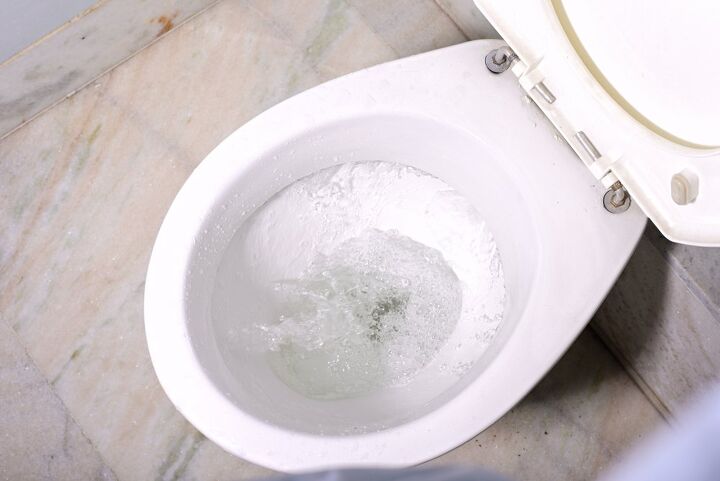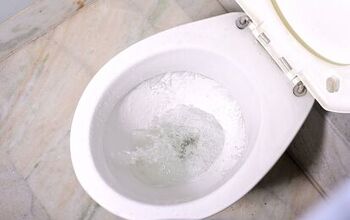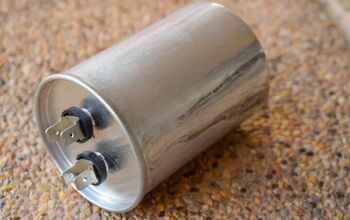Sink Gurgles When Toilet Flushes? (We Have A Fix)

If you turn on your sink and hear a gurgling sound coming from it, then it could be that your sink’s P-trap has air passing through it. This is not good, and it indicates that there’s either a clog somewhere or something else is causing the water to drain slowly.
But sometimes sink gurgling can happen when a toilet is flushed, and why this happens—as well as solutions to this problem—will be the focus of this article.
Tackling a gurgling sink by yourself could be challenging, which is why contacting a professional plumber is recommended. A pro will have all the tools, know-how, and experience necessary to fix a gurgling sink, no matter what’s causing this problem.
When a sink gurgles and bubbles at the same time a toilet is flushed, it’s likely there’s blockage in the main pipe vent. To resolve this problem, identify where the block is and clear it. If the sink gurgles and bubbles without the toilet being flushed, then it’s probably a sink-specific problem, most likely that the P-trap has air in it.
Do You Need to Hire a Plumber?
Get free, zero-commitment quotes from pro contractors near you.

Why This Happens
There are two common explanations for a gurgling sink, and while these causes are related, they each have their own unique solution. First, what causes a gurgling sink—when no flushing is involved—will be explained, as with this information you’ll be able to distinguish a toilet-related problem from a non-toilet problem.
When There’s Air in the Sink’s P-Trap
If you run your sink and notice a gurgling sound when the water goes down the drain, then it’s likely there’s air trapped inside the sink’s P-trap. Bubbles coming up from the sink after all water in the bowl has drained is also an indication of this.
Air is a necessary part of all plumbing systems. But when the air is pressurized, such can prevent the sink’s P-trap from forming a proper seal. In a high-pressure environment like this, a vacuum will pull air through the P-trap when water runs down the drain. Air being suctioned into the P-trap is what causes the gurgling and bubbles.
How Air Can Get Inside a P-Trap
If the P-trap is not installed correctly, then the aforementioned problem can be a consequence of this. Also, if the sink’s vent is not the proper distance away from the P-trap, then both gurgling and bubbles are likely to occur.
A clogged drain could also make the P-trap malfunction. If you flush the toilet and no gurgling sound manifests, then you’ll know the P-trap is likely the source of the gurgling.
Readjust the P-trap or purchase a new one if the one you have is worn. If you don’t want to tinker with the P-trap by yourself, get help from a professional plumber. They’ll know whether or not the gurgling and bubbles are related to the P-trap.
When Toilet Flushing Causes the Gurgling
If there’s no gurgling or bubbling when you run the sink by itself—but both these elements manifest when a nearby toilet is flushed—then there’s probably something wrong with the toilet’s vent or the main plumbing vent.
Toilets and sinks often utilize the same main vent pipe, but each fixture is required to have its own vent. Because these fixtures are connected in this way, when either the toilet vent or main vent get blocked, the result of this blockage will most clearly manifest in the sink.
Other Consequences of a Vent Block
Along with the gurgling and bubbling, the sink will drain slower than usual. This is because the airflow is poor, and the air is supposed to offset the negative pressure created by the flowing water.
In this situation, suction is created against the direction of the flowing water, and in some cases flow can stop entirely. This doesn’t happen often, in large part because the sink P-trap can take on air when there’s nowhere else for the air to go. Since the sink P-trap is close to the toilet, this explains why it’s the last resort for air that’s looking to escape.
But if the vent block is significant, then the suction may be intense enough to empty the P-trap entirely, and you’ll know this has happened if you smell a foul odor coming from the sink or toilet—the smell is sewer gas filling the waterless P-trap.
How to Ensure the Vent Doesn’t Get Blocked
Every plumbing fixture in a home or building has a vent attached to it, and all these vents connect to one main vent; this vent exits the property via the roof. If the vent stack is uncovered—and say for example there are trees overhead—then the vent stack can get blocked by a range of debris.
Moreover, some plumbing configurations are particularly prone to vent blockage, especially those which have the vent in close proximity to the waste pipe. In this instance, the sink gurgling could be caused by a clogged toilet, especially if the toilet and sink share a vent.
Here, the toilet will need to be unclogged. Use a plunger, drain cleaner, and/or a snake to dislodge the blockage.
Climate-Specific Issues
It’s also not uncommon for birds and other small animals to make a vent their home, and this is especially true in colder climates; the vent is warm, after all.
For homes and businesses in cold climates, there’s also the possibility that a vent will freeze, and freezing is more likely when the vent pipe is too small and/or there’s improper insulation in the attic. When a vent pipe is frozen, the warm air will condense near the vent opening and eventually turn to ice. When the vent is completely blocked, gurgling, bubbling, and other consequences may manifest.
How to Fix This Problem DIY
While the gurgling sound may seem innocuous, it’s not. It indicates that there is not proper ventilation in the plumbing system. You shouldn’t accept poor airflow, as the blockage will only get worse.
If the gurgling sound is produced by the P-trap, then you’ll just need to flush the air out by filling the trap with water. Just keep in mind that when the P-trap is empty, there won’t be a barrier keeping back the nasty, methane-rich sewer gas, so you should prepare for this.
But if this isn’t the problem, then you’ll need to clear the vents. The first thing you’ll need to do is grab a plunger. Plunge using proper technique. Once you’re sure that plunging isn’t going to fix the problem, you should move on to other solutions.
Other Solutions
If plunging isn’t doing the trick, then you’ll need to get up on the roof and see if the main vent stack is blocked. There could be leaves or debris blocking the vent, or perhaps the vent’s screen is dirty. There’s a debate over whether or not screens are useful, and in this instance it can be seen why having a screen may be problematic.
After debris has been cleared and the screen is clean, you should spray water down the pipe with a garden hose, as doing so will ensure that any remaining blockage is flushed out. If the water bubbles back, then you’ll know that the block has not been eliminated.
In this instance, you could try using a sewer auger. But if you don’t want to use this tool, you could get a professional vent cleaning service to help you.
There may also be a problem with the air-admittance valve, which is commonly known as the cheater valve. This is connected to the horizontal arm of the P-trap.
Using pliers, you should replace this if it’s worn. This is an inexpensive part that plumbers sometimes install when there’s poor venting for the sink.
Related Questions
Does pouring boiling water down the vent pipe work in the wintertime?
While pouring boiling water down a vent pipe to combat freezing may seem like a good idea, this isn’t the case because the rapid temperature change caused by this could be destructive. If your vent pipe is thoroughly frozen, and you respond by pouring boiling water into it, then the pipe could expand, or burst, and be rendered useless.And if damage occurs in a part of the vent that’s hard to access, both repair and replacement are likely to be costly. It’s best to thaw out the vent slowly if it becomes frozen.
How does one get the best possible results from plunging?
To ensure you’re plumbing effectively, you should seal all nearby plumbing fixtures in the bathroom. Since all the fixtures are connected to the same drain line, a bad clog in the line will affect all the fixtures.Sealing everything but the toilet will ensure you’re able to plunge and deliver maximum pressure—this should dislodge whatever is causing the clog. Duct tape can be used to create an effective seal.
Do You Need to Hire a Plumber?
Get free, zero-commitment quotes from pro contractors near you.

Final Note
When the sink gurgles and bubbles during a toilet flush, it’s most likely because there’s a vent block somewhere. Addressing the vent block on your own can be difficult, and this is why consulting a professional plumber has been suggested so many times. Getting professional help will ensure the vent gets cleared, on the first time and without any headaches.
Related Guide

Matt loves everything DIY. He has been learning and practicing different trades since he was a kid, and he's often the first one called when a friend or family member needs a helping hand at home. Matt loves to work with wood and stone, and landscaping is by far his most favorite pastime.
More by Matthew Mountain













![10 Best Cordless Leaf Blowers – [2022 Reviews & Ultimate Guide]](https://cdn-fastly.upgradedhome.com/media/2023/07/31/9070789/10-best-cordless-leaf-blowers-2022-reviews-ultimate-guide.jpg?size=350x220)


![10 Most Dangerous Neighborhoods in Baltimore [Updated]](https://cdn-fastly.upgradedhome.com/media/2023/07/31/9075655/10-most-dangerous-neighborhoods-in-baltimore-updated.jpg?size=350x220)










